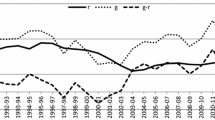Abstract
The macroeconometric simulation model AMOD1 and the optimization algorithm OPTCON are used to evaluate fiscal policies for Austria since the late seventies. In particular, the question of optimal (debt stabilizing) fiscal policies for the past and for the future is analyzed within the framework of a medium-scaled simulation model. The first set of optimization experiments aims to assess optimal fiscal policies for debt stabilization for the historical period 1978–2000 while trying to maintain reasonable growth rates of approximately 2 percent of real GDP. Optimal values of the instruments and the targets are compared to empirical data for Austria. A second set of simulations calculates optimal paths for the fiscal instruments for the period 2001-2010, particularly with respect to the criteria of the Stability and Growth Pact, which is mandatory for member states of the Euro zone.
Similar content being viewed by others
References
Breuss, F. and Schebeck, F. (1988) 'Gesamtwirtschaftliche Effekte der Steuerreform 1988', Wifo-Monatsberichte 11/1988, 623–633.
Breuss, F. (1999) 'Wozu fiskalische Tragfähigkeit in der Wirtschafts-und Währungsunion?' in R. Neck and R. Holzmann, eds.
Chow, G. C. (1975) Analysis and Control of Dynamic Economic Systems, NewYork.
Chow, G. C. (1981) Econometric Analysis by Control Methods, NewYork.
Haber, G. (2000) AMOD1. Ein makroökonometrisches Modell für Österreich, Doctoral Thesis, Vienna University of Economics and Business Administration, Vienna.
Karbuz, S., Matulka, J., and Neck, R. (1994) 'OPTCON: An Algorithm for the Optimal Control of Nonlinear Stochastic Models, User Manual', Discussion Paper No. 284, University of Bielefeld, Faculty of Economic Sciences, Bielefeld.
Kendrick, D. (1981) Stochastic Control for Economic Models, New York.
Matulka, J. and Neck, R. (1992) 'OPTCON: An Algorithm for the Optimal Control of Nonlinear Stochastic Models', Annals of Operations Research 37, 375–401.
Neck, R., Haber, G., and McKibbin, W. J. (2000) 'Macroeconomic Policy Design in the European Union: A Numerical Game Approach', Empirica 26(4), 319–335.
Neck, R. and Holzmann, R. (eds.) (1999) Was wird aus Euroland? Manz, Vienna.
Neck, R., Holzmann, R., and Schneider, F. (eds.) (2000), Staatsschulden am Ende? Manz, Vienna.
Neck, R. and Karbuz, S. (1997) 'Optimal Budgetary Policies for Austria', Working Paper 9717, Ludwig Boltzmann Institute for Economic Policy Analysis, Vienna.
Author information
Authors and Affiliations
Rights and permissions
About this article
Cite this article
Haber, G. Simulation Analysis of Public Debt and Fiscal Deficit in Austria – Optimal Economic Policies for the Past and the Future. Empirica 28, 69–95 (2001). https://doi.org/10.1023/A:1010991922192
Issue Date:
DOI: https://doi.org/10.1023/A:1010991922192




